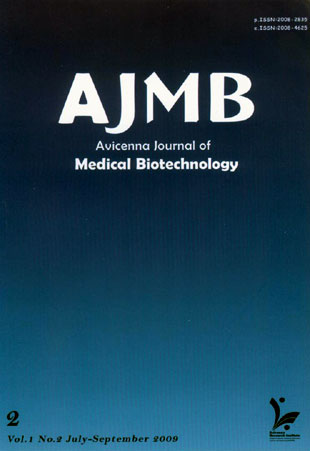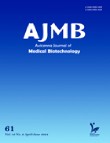فهرست مطالب

Avicenna Journal of Medical Biotechnology
Volume:1 Issue: 2, Jul-Sep 2009
- تاریخ انتشار: 1388/07/11
- تعداد عناوین: 9
-
-
EDITORIALPage 53
-
Page 55The eukaryotic complexity involves the expression and regulation of genes via RNA-DNA, RNA-RNA, DNA-protein and RNA-protein interactions. Recently, the role of RNA molecules in the regulation of genes in higher organisms has become more evident, especially with the discovery that about 97% of the transcriptional output in higher organisms are represented as noncoding RNAs: rRNA, snoRNAs, tRNA, transposable elements, 5'' and 3'' untranslated regions, introns, intergenic regions and microRNAs. MicroRNAs function by negatively regulating gene expression via degradation or translational inhibition of their target mRNAs and thus participate in a wide variety of physiological and pathological cellular processes including: development, cell proliferation, differentiation, and apoptosis pathways. MicroRNA expression profiles in many types of cancers have been identified. Recent reports have revealed that the expression profiles of microRNAs change in various human cancers and appear to function as oncogenes or tumor suppressors. Abnormal microRNA expression has increasingly become a common feature of human cancers. In this review, we summarize the latest progress on the involvement of microRNAs in different types of cancer and their potential use as potential diagnostic and prognostic tumor biomarkers in the future.
-
Page 71The field of vaccinology provides excellent promises to control different infectious and non-infectious diseases. Genetic immunization as a new tool in this area by using naked DNA has been shown to induce humoral as well as cellular immune responses with high efficiency. This demonstrates the enormous potential of this strategy for vaccination purposes. DNA vaccines have been widely used to develop vaccines against various pathogens as well as cancer, autoimmune diseases and allergy. However, despite their successful application in many pre-clinical disease models, their potency in human clinical trials has been insufficient to provide protective immunity. Several strategies have been applied to increase the potency of DNA vaccine. Among these strategies, the linkage of antigens to Heat Shock Proteins (HSPs) and the utilization of different delivery systems have been demonstrated as efficient approaches for increasing the potency of DNA vaccines. The uptake of DNA plasmids by cells upon injection is inefficient. Two basic delivery approaches including physical delivery to achieve higher levels of antigen production and formulation with microparticles to target Antigen-Presenting Cells (APCs) are effective in animal models. Alternatively, different regimens called prime-boost vaccination are also effective. In this regimen, naked DNA is utilized to prime the immune system and either recombinant viral vector or purified recombinant protein with proper adjuvant is used for boosting. In this review, we discuss recent advances in upgrading the efficiency of DNA vaccination in animal models.
-
Page 89In this study, an attempt has been made to expound the Iranian law of intellectual property in relation to biotechnology. The most important themes studied are patents, industrial designs and trade marks. The latest relevant piece of legislation concerning the subject matters was passed in March 2008. However, the history of laws and regulations in this field goes back to early twentieth century (i.e. 1925). In this review, on the basis of the latest law passed in 2008, the topics explored are the responsible authority, patentable items and criteria, excluded items, registration procedure, rights conferred and sanctions. At the end, an attempt is made to put forward a few points as an analysis of the above Law from a critical point of view.
-
Page 95Although, coumarins are a group of compounds which are naturally found in some plants, they can be synthetically produced as well. Because of their diverse derivatives, origin and properties most of them can be used for medicinal purposes. For example, they can be used against fungal diseases or in studying structure and biological properties of antifungal agents to discover new compounds with the similar activity. A Structure Property/Activity Relationship (SAR) can be utilized in prediction of biological activity of desired molecules.
-
Page 105Gonadotropin releasing hormone (GnRH) plays a key role in reproduction. This decapeptide is synthesized and released by hypothalamus and induces the pituitary gonadotrop cells to release pituitary gonadotropin hormones. In some extrapituitary compartments GnRH and its receptor act as part of the autocrine regulatory system of cell proliferation. The anticancer activity of GnRH and its analogues has been observed by many researchers. In this study the anticancer activity of a new analogue of GnRH and triptorelin was investigated by cell proliferation assay. Results indicate that proliferation of human breast and ovarian cancer cell lines are dose-dependently inhibited. The inhibitory efficiency of the new analogue is proved to be higher than the original triptorelin. In addition to its antimitogenic activity, evidence was found for the involvement of the apoptotic mechanism in the action of the new analogue and triptorelin. In conclusion, the new analogue can be considered as a good pharmaceutical candidate.
-
Page 111Many reports have been published about the biogenesis of silver nanoparticles using several plant extracts such as Pelargonium graveolens (P.graveolens- geranium) and Azadirachta indica (neem) but the capacity of their natural reducing constituents to form silver nanoparticles has not yet been studied. In this research the synthesis of silver nanoparticles using geraniol has been investigated. We successfully synthesized uniformly dispersed silver nanoparticles with a uniform size and shape in the range of 1 to 10 nm with an average size of 6 nm. Also the cytotoxicity of the prepared silver nanoparticles was investigated using a cancer cell line (Fibrosarcoma-Wehi 164). The cytotoxicity analysis of the sample shows a direct dose-response relationship; cytotoxicity increased at higher concentrations. At concentration of 1 µg/ml, silver nanoparticles was able to inhibit the cell line’s growth by less than 30%. Conversly, the presence of 5 µg/ml of silver nanoparticlse significantly inhibited the cell line’s growth (> 60%). The concentration necessary to produce 50% cell death was 2.6 µg/ml for this silver nanoparticles preapared with geraniol.
-
New Variations in the Promoter Regions of Human DOCK4 and RAP1A Genes, and Coding Regions of RAP1A in Sporadic Breast TumorsPage 117Breast cancer is the most common cancer among women in developed countries. The prevalence of the disease is increasing in the world. Its annual incidence among Iranian women is about 7000 cases. RAP1A, a tumor suppressor gene, is located at 1p13.3 and plays an important role in the cellular adhesion pathway and is involved in the pathogenesis of breast cancer. The DOCK4 gene, which is located at 7q31.1, specifically activates RAP1A gene. In the present study, DNA samples from 64 cases of sporadic breast tumors (referred to Mehrad Hospital in Tehran) were screened using PCR-SSCP method and the number of observed variations compared with the control group (100 normal women). Mutation detection for coding exons of RAP1A gene and the 500 bp upstream of transcription initiation site as promoters of both DOCK4 and RAP1A were carried out and compared with the control group. The promoter region of DOCK4 showed a heterozygous mutation with G>A transition at nucleotide -303 in a fibroadenoma case. With regard to RAP1A we found a heterozygous mutation, G>A transition in an adenoid cystic carcinoma case, and another heterozygous mutation, G>T transversion in an intraductal papilloma case both at nucleotide +45. A homozygous variation, T>A transversion was also found at nucleotide +29 of a fibroadenoma case. The differences in the frequency of variations mentioned above were not statistically significant. However Fisher’s exact showed significant difference for T>A transversion. Although, the higher frequency of these mutations and variations may be related to the disease, a larger sample size is needed for the confirmation of our findings.
-
Page 125Gene expression profiling of ovarian carcinoma tissues has shown an increase of four-fold expression of SORT1 gene. Sortilin 1 (NTR-3) is a 95-100 kDa protein normally expressed in heart, brain, placenta, skeletal muscle, spinal cord, thyroid, and testis. However, its expression has never been reported in normal ovary. Here, we report expression of sortilin 1 in ovarian carcinoma tissues both at gene and protein levels. Sortilin 1 was expressed in all ovarian carcinoma patients (n=15) as well as ovarian carcinoma cell lines (n=5) regardless of their phenotypic characteristics. Non-malignant ovaries (n=6) did not express sortilin 1. The molecular basis for this ectopic expression is not yet clear. Our results showed a major cell surface expression of sortilin 1 rather than ER-Golgi compartment where it is mainly expressed. This finding may introduce sortilin 1 as a novel tumor marker for diagnosis of ovarian carcinoma and may signify its therapeutic value in targeted therapy.


